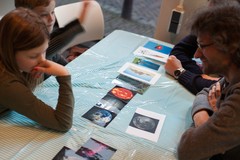After four successful sessions, EU Universe Awareness' Family Science has come to an end; for now. During these sessions local families with young children were given the chance to get a taste of science at the Museum Boerhaave in Leiden, the Netherlands. Together with the Dutch UNAWE team, the families took part in scientific activities, and acted just like real research teams. This was to show that anyone can do science and above all, that it can be a lot of fun!
Every session had a unique theme. The first session was all about sorting and classifying; the basis of every science topic. Five families participated in this session and all were very enthusiastic about the different activities they took part in. They worked together in teams, noted down their ideas and observations, tried things out and eventually formed their own theories; just like real scientists! During the break between each session the young future-scientists were taken on a tour through the museum.
The Moon took centre stage in the second session of Family Science. We see the Moon almost every night, but how much do we actually know about it? The families took a good look at a picture of the Moon and studied its appearance before putting a puzzle of it together. They also studied how the phases of the Moon work by walking around a bright lamp with styrofoam balls. Everyone was amazed during the last part of the session, when they were shown the enormous distance between the Earth and the Moon.
The third session continued were the second session ended; scaling. With the help of beads, crêpe paper, yarn and big sheets of paper, the families were able to gain some insight in to the distance to the Sun and they made a model of the Solar System to scale using clay. Afterwards it was time to work with some real big numbers. The families were asked how much sand they thought was needed to depict the Milky Way. The right answer to this is 25,000 cups of sand!
The fourth, and last, session was all about invisible light. This was also the session with the most families in attendance; ten families came to the Boerhaave Museum to dive in to this exciting subject. Like true detectives they deciphered codes using different kinds of light. They could use UV light, infrared light and, of course, visible light. After the codes were cracked, the little detectives were allowed to experiment with the different sorts of light to make their own codes.
Over the months, as the sessions continued, they became increasingly popular. It seems like people are getting more and more excited about science! If you like the sound of these activities and would like to attend these sessions (again); keep an eye on the UNAWE website to find out where and when we will continue these inspiring sessions!













